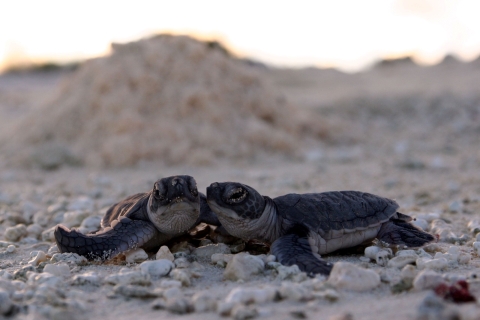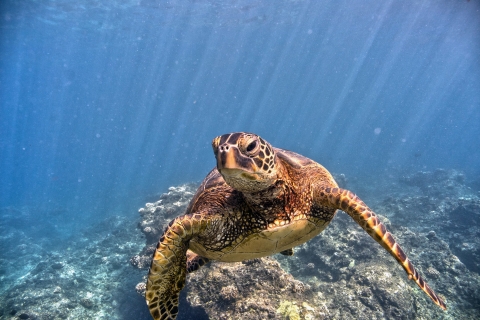Scientific name: Chelonia mydas
Hawaiian name: Honu
Common name: Hawaiian Green sea turtle
Status: Endangered in Hawaiian waters
On one of many cosmic nights, the honu, or Hawaiian Green sea turtle, was created - as recounted in the Hawaiian creation chant, Kumulipo. Born in the realm of pō, or darkness where life is produced and spirits return, the honu continues to be sacred to many Hawaiian families today. For some in Hawaiʻi, honu are ‘aumākua, or spiritual guardians.
"The night gives birth to rough-backed turtles."
- Hawaiian creation chant, Kumulipo
Habitat and Range
Honu are a migratory species, traveling hundreds or thousands of miles from foraging areas to nesting beaches. Over 95% of the Hawaiian Green sea turtle population nests in French Frigate Shoals in Papahānaumokuākea Marine National Monument. They largely travel to the main Hawaiian Islands to forage for food and bask on the beaches. Limited nesting and foraging occurs in other locations in the Pacific such as America Samoa, Guam, and the Commonwealth of the Northern Mariana Islands. When they are not migrating, honu remain in shallow waters like lagoons, reefs, bays, and shoals to feed and nest along open, undisturbed beaches.
Green sea turtles are also found throughout the world. Other genetically distinct populations range all over the Pacific, the Caribbean and Atlantic coasts of North and South America, the Mediterranean Sea, and northern parts of the Indian Ocean. But the Hawaiian Green sea turtle exists only in Hawaiian archipelago.
Diet and Life Cycle
Hatchling honu eat a diet of fish and plants, but then switch to a mostly herbivorous diet of algae and seagrass between ages 5 and 7. Less frequently, juveniles and adults may eat invertebrates like sponges and jellyfish.
Their lifespan is estimated to be 60 to 70 years, but honu do not reach sexual maturity until 25 to 40 years! And the length of reproductivity varies: ranging from 17 to 23 years.
Once a female can reproduce, she will return to her nesting site every 2 to 5 years and lay anywhere between 3 and 9 clutches. Each clutch varies between 75 to 200 eggs, with an interval of about 12 days between each clutch. After months of laying eggs, she returns to the sea to forage. Depending on the temperatures, the eggs may hatch after 45 to 75 days; and the hatchlings emerge usually at night to travel toward the brightest horizon: the ocean.
Threats to the Species
- Predators such as crabs, birds, mongoose, rats, pigs, dogs, fish, and sharks.
- Intentional poaching and harvesting of eggs.
- Accidental by-catch, entanglement in fishing lines and nets.
- Loss of critical nesting beaches due to changing climates.
- Disease.
- Ocean pollution and marine debris.
- Coastal development that degrades nesting habitat.
- Artificial lights that confuse hatchlings from finding the ocean.
Reason for Hope
In Hawaiʻi, thanks to long term collaboration between the state of Hawaiʻi, federal agencies like the National Oceanic and Atmospheric Administration, and dedicated local volunteers, the honu population has been increasing over the past two decades.
Innovative research, public outreach, and management efforts that protect habitat and prohibit harvesting and collection of honu have helped protect this vulnerable species.
You can volunteer to help honu in Hawaiʻi by contacting Hawaii Marine Animal Response or Hawaii Wildlife Fund
Fun Facts
- The largest of all hard-shelled sea turtles, the Green Sea Turtle is named not for their shell color appearance, but for the color of their fat and cartilage.
- Honu are considered “sea cows” as they graze on limu, seagrass, and invertebrates along coral reefs and rocky shorelines.
- They can dive up to 1,500 ft.
- They can live up to 100 years.
Further Reading
- Hawaii Wildlife Viewing Guides - What to do if you see a honu in Hawaiʻi.
- NOAA Fisheries Green Turtle Species Information
###
The U.S. Fish and Wildlife Service works with others to conserve, protect, and enhance fish, wildlife, plants, and their habitats for the continuing benefit of the American people. For more information, visit www.fws.gov/pacificislands, or connect with us through any of these social media channels at https://www.facebook.com/PacificIslandsFWS, www.flickr.com/photos/usfwspacific/, https://medium.com/usfwspacificislands or www.twitter.com/USFWSPacific








